Fault Code 16: High Integrity Link Gen1 ECA
J1587: MID 130 SID 248 FMI 2
J1939: SA 3 SPN 625 FMI 2
Overview
The High Integrity Link (HIL) is a Controller Area Network (CAN) high-speed proprietary data link that communicates data between the Transmission Electronic Control Unit (TECU), Electronic Clutch Actuator (ECA), and if equipped, Eaton Push Button Shift Control (PBSC). The portion of the HIL that connects the TECU to the ECA is contained within the Transmission Harness. The portion of the HIL that connects the TECU to the PBSC is contained within the Vehicle Harness. Fault Code 16 indicates a loss of communication of the HIL.
Detection
The TECU monitors communication with the Shift Control Device (if equipped) and the ECA over the HIL Link. If the TECU is unable to receive any messages from the other components on the HIL, Fault Code 16 sets Active.
Conditions to Set Fault Code Active
FMI 2 – Data Erratic: TECU does not receive any messages over the HIL for more than 5 seconds.
Fallback
FMI 2
- Transmission may not engage a gear from neutral.
- Once the transmission down shifts to the start gear, no up shifts occur as long as the fault code is Active.
- If equipped with an Eaton PBSC:
- “F” flashes in gear display.
- Service light flashes (if equipped).
- If equipped with an Eaton Cobra Shift Lever or OEM J1939 Shift Controller:
- “F” does not flash in gear display.
- Service lamp does not flash.
Conditions to Set Fault Code Inactive
FMI 2: Communication between components is restored for 5 seconds.
Possible Causes
FMI 2
- HIL
- Wiring shorted to ground, shorted to power or open
- Bent, spread, corroded or loose terminals
- Missing terminating resistor
- Transmission Harness
- Wiring shorted to ground, shorted to power or open
- Bent, spread, corroded or loose terminals
- Seal failure in 8-Way ECA Connector
- Loss of ignition voltage to ECA before power up
- ECA
- Failed ECA software download
- Bent, spread, corroded or loose terminals
- Contamination in 3-Way ECA Connector
- Contamination in 8-Way ECA Connector
- Internal failure
- Vehicle Batteries
- Internal failure
- Vehicle Power and Ground Supply to ECA
- Bent, spread, corroded or loose terminals
- Wiring shorted to ground, shorted to power or open
- Seal failure on 3-Way ECA Connector
- Disconnected 3-Way ECA Connector
- Vehicle Power and Ground Supply to TECU
- Corroded or loose power supply connections to TECU
- TECU
- Internal failure
- PBSC
- Internal failure
Component Identification
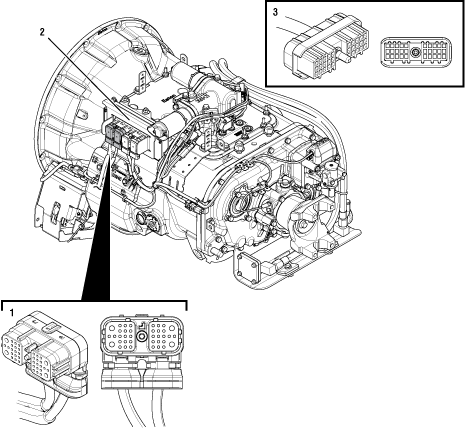 |
1. 38-Way Vehicle Harness Connector 2. Transmission Electronic Control Unit (TECU) 3. 30-Way Push Button Shift Control Device (PBSC) Connector |
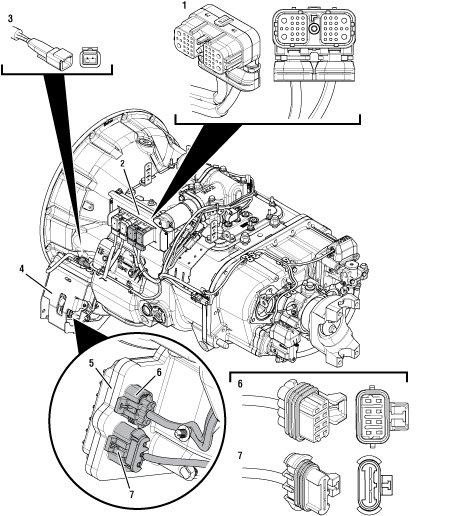 |
1. 38-Way Transmission Harness Connector 2. Transmission Electronic Control Unit (TECU) 3. 2-Way Terminating Resistor Connector Body 4. Gen1 ECA Shield 5. Gen1 Electronic Clutch Actuator (ECA) 6. 8-Way Gen1 ECA Connector 7. 3-Way Gen1 ECA Connector |
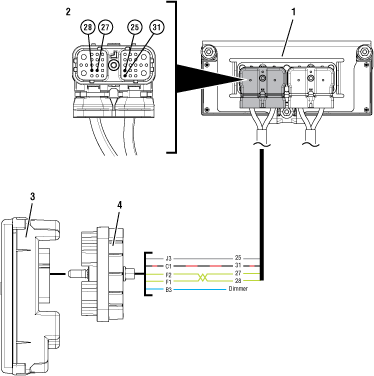 |
1. Transmission Electronic Control Unit (TECU) 2. 38-Way Vehicle Harness Connector 3. Eaton Push Button Shift Control Device (PBSC) 4. 30-Way PBSC Connector |
 |
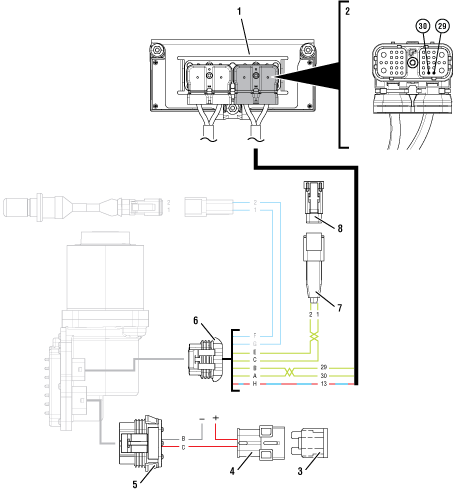 | |
1. Transmission Electronic Control Unit (TECU) 2. 38-Way Transmission Harness Connector 3. 40-amp Fuse 4. In-line Fuse Holder 5. 3-Way Gen1 ECA Connector | 6. 8-Way Gen1 ECA Connector 7. 2-Way Terminating Resistor Connector Body 8. 2-Way High Integrity Link (HIL) Terminating Resistor |
 |
Fault Code 16 Troubleshooting Gen1 ECA
Set parking brake and chock wheels.
Inspect ECA OEM Power Supply Connector, reference image below.
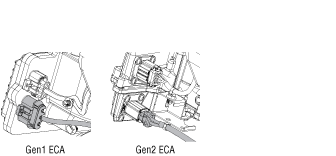
If equipped with a Gen1 ECA, Go to Step B
If equipped with a Gen2 ECA, go to Fault Code 16: High Integrity Link Gen2 ECA.
Determine if an ECA software download was performed immediately before Fault Code 16 set Active.
If an ECA software download was not recently performed, Go to Step D
If Fault Code 16 became Active immediately following an ECA software download, download may have failed. Go to Step C
Key off.
Note: Allow 2–3 minutes for the TECU to perform a complete power-down sequence before proceeding.
Key on with engine off.
Connect ServiceRanger.
Use ServiceRanger to program or recover the TECU and ECA software to latest available levels.
If software does not download correctly, contact Eaton at (800) 826-4357.
If software downloads correctly and Fault Code 16 becomes Inactive, test complete. Go to Step V
If software downloads correctly, but Fault Code 16 remains Active, Go to Step D
Key off.
Note: Allow 2–3 minutes for the TECU to perform a complete power-down sequence before proceeding.
If vehicle is equipped with a Bulkhead Connection, disconnect Bulkhead Connector. Inspect connector for loose terminals, corrosion and bent or spread pins.
Wiggle wiring connections to the Bulkhead Connector to verify the pins are not loose and are secure within the connector.
Reconnect Bulkhead Connector.
If no Bulkhead Connection is present, Go to Step E
If damage or looseness is found, refer to OEM guidelines for repair or replacement of Bulkhead Connection. Go to Step V
If no damage is found, Go to Step E
Record the transmission fault codes, FMIs, occurrences, and timestamps from the Service Activity Report created during the Diagnostic Procedure.
Check vehicle cab to determine the type of shift control device installed on the vehicle.

If equipped with an Eaton PBSC, Go to Step F
If equipped with any other shift device, including Eaton Cobra Lever or an OEM Shift Device, Go to Step M
Retrieve fault code information from the Service Activity Report.
If Fault Code 16 is Active, Go to Step H
If Fault Code 16 is Inactive, Go to Step G
Set parking brake and chock wheels.
Place transmission in PD Mode. See more about Product Diagnostic (PD) Mode.
Note: Transmission does not enter PD Mode when Active fault codes exist.

Wiggle wiring and connections from the batteries to the 3-Way Connector at the ECA. Look for signs of pinched or chafed wiring. Verify all connections are clean and tight.
Wiggle wiring and connections of the Transmission Harness from the 8-Way Gen1 ECA Connector to the 38-Way Vehicle Harness Connector at the TECU. Look for signs of pinched or chafed wiring. Verify all connections are clean and tight.
Wiggle wiring and connections between the 30-Way PBSC Connector to the 38-Way Vehicle Harness Connector at the TECU. Look for signs of pinched or chafed wiring. Verify all connections are clean and tight.
Exit PD Mode by powering down.
Note: Allow 2–3 minutes for the TECU to perform a complete power-down sequence before proceeding.
If any fault set Active while wiggling the ECA Power Harness, refer to OEM guidelines for repair or replacement of the ECA Power Harness. Go to Step V
If any fault set Active while wiggling the Transmission Harness, replace Transmission Harness. Go to Step V
If any fault set Active while wiggling the wiring between the PBSC and TECU, refer to OEM guidelines for repair or replacement of the OEM wiring. Go to Step V
If no fault codes set Active, Go to Step H
Key off.
Disconnect 30-Way PBSC Connector.
Inspect 30-Way for loose terminals, corrosion and bent or spread pins.
If damage is found, refer to OEM guidelines for repair or replacement of 30-Way Connector and harness. Go to Step V
If no damage is found, Go to Step I
Key on with engine off.
Measure voltage between 30-Way Pin C1 and Pin J3. Record reading in table.
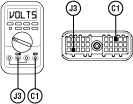
Compare reading(s) in table.
If readings are in range, Go to Step K
If readings are out of range, Go to Step J
| Pins | Range | Reading(s) |
|---|---|---|
| C1 to J3 | Within 1.2 V of Battery Voltage |
Key off.
Disconnect 38-Way Vehicle Harness Connector from TECU.
Inspect 38-Way for loose terminals, corrosion and bent or spread pins.
Measure resistance between 38-Way Vehicle Harness Connector Pin 31 and 30-Way PBSC Connector Pin C1. Record reading in table.
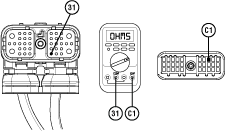
Measure resistance between 38-Way Vehicle Harness Connector Pin 31 and ground. Record reading in table.
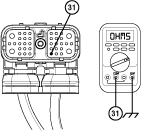
Measure resistance between 38-Way Vehicle Harness Connector Pin 25 and 30-Way PBSC Connector Pin J3. Record reading in table.
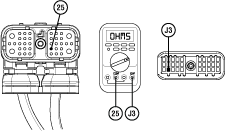
Compare reading(s) in table.
If readings are in range, replace Transmission Electronic Control Unit (TECU). Go to Step V
If readings are out of range, refer to OEM guidelines for repair or replacement of vehicle harness between TECU and PBSC. Go to Step V
| Pins | Range | Reading(s) |
|---|---|---|
| 31 to C1 | 0.0–0.3 ohms | |
| 31 to Ground | Open Circuit (OL) | |
| 25 to J3 | 0.0–0.3 ohms |
Key off.
Disconnect 38-Way Vehicle Harness Connector from TECU.
Inspect 38-Way TECU Vehicle Harness Connector for loose terminals, corrosion and bent or spread pins.
Measure resistance between 38-Way Vehicle Harness Connector Pin 28 and 30-Way PBSC Connector Pin F1. Record reading in table.
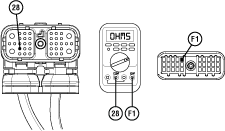
Measure resistance between 38-Way Vehicle Harness Connector Pin 28 and Ground. Record reading in table.
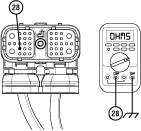
Compare reading(s) in table.
If readings are in range, Go to Step L
If readings are out of range, refer to OEM guidelines for repair or replacement of High Integrity Link (HIL) between the PBSC and TECU. Go to Step V
| Pins | Range | Reading(s) |
|---|---|---|
| 28 to F1 | 0.0–0.6 ohms | |
| 28 to Ground | Open Circuit (OL) |
Key off.
Measure resistance between 38-Way Vehicle Harness Connector Pin 27 and 30-Way PBSC Connector Pin F2. Record reading in table.
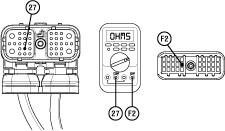
Compare reading(s) in table.
If readings are in range, Go to Step O
If readings are out of range, refer to OEM guidelines for repair or replacement of High Integrity Link (HIL) between the PBSC and TECU. Go to Step V
| Pins | Range | Reading(s) |
|---|---|---|
| 27 to F2 | 0.0–0.6 ohms |
Retrieve fault code information from the Service Activity Report.
If Fault Code 16 is Active, Go to Step O
If Fault Code 16 is Inactive, Go to Step N
Set parking brake and chock wheels.
Place transmission in PD Mode. See more about Product Diagnostic (PD) Mode.
Note: Transmission does not enter PD Mode when Active fault codes exists.

Wiggle wiring and connections from the batteries to the 3-Way Connector at the ECA. Look for signs of pinched or chafed wiring. Verify all connections are clean and tight.
Wiggle wiring and connections of the Transmission Harness from the 8-Way Gen1 ECA Connector to the 38-Way Vehicle Harness Connector at the TECU. Look for signs of pinched or chafed wiring. Verify all connections are clean and tight.
Exit PD Mode by powering down.
Note: Allow 2–3 minutes for the TECU to perform a complete power-down sequence before proceeding.
If any fault codes set Active while wiggling the ECA Power Harness, refer to OEM guidelines for repair or replacement of the ECA Power Harness. Go to Step V
If no fault codes set Active, Go to Step O
Key off.
Inspect the ECA Power Supply Harness between the batteries and the ECA for signs of rubbing or chafing to the wiring.
Inspect the ECA 40-amp In-line Fusible Link or Fuse Holder Con-nections for damage and bent, spread, corroded or loose terminals.
Note: Some chassis use a power and ground distri-bution block separate from the battery or may route power and ground to the starter. Be sure to clean and inspect connections at this location and at the battery.
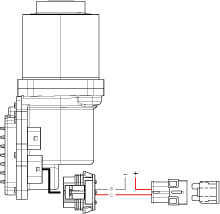
If damage to the ECA Power Supply Harness is found, refer to OEM guidelines for repair or replacement. Go to Step V
If no damage is found, Go to Step P
Key off.
Disconnect 3-Way ECA Connector.
Verify connector is free from any corrosion; the ter-minals are not bent, spread or loose; and there is no damage to the connector body.
Confirm the 3-Way Gen1 ECA Connector has a seal plug in Cavity A.
Inspect ECA side of 3-Way ECA Connector, verify connector is free from any corrosion, the terminals are not bent, spread or loose; and there is no damage to the connector body.
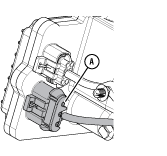
If damage to the 3-Way Gen1 ECA Connector is found and/or missing seal plug in Cavity A, refer to OEM guidelines for repair or replace-ment. Go to Step V
If damage to the ECA side of 3-Way Gen1 ECA Connector is found, replace Electronic Clutch Actuator (ECA). Go to Step V
If no damage is found, Go to Step Q
Key off.
Measure voltage between 3-Way Gen1 ECA Connector Pin C (Battery positive) and Pin B (Battery nega-tive). Record reading in table.
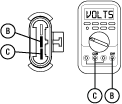
Compare reading(s) in table.
If readings are out of range, refer to OEM guidelines for repair or replacement of the ECA Power Supply Harness. Go to Step V
If readings are in range, Go to Step R
| Pins | Range | Reading(s) |
|---|---|---|
| C to B | Within 1.2 V of Battery Positive (+) |
Key off.
Measure voltage between 3-Way Gen1 ECA Connector Pin C (Battery positive) and ground. Record read-ing in table.

Compare reading(s) in table.
If readings are out of range, Pin C (Battery posi-tive) and Pin B (Battery negative) wires are incorrectly pinned in the ECA 3-Way Connector. Refer to OEM requirements for repair or replacement. Go to Step V
If readings are in range, Go to Step S
| Pins | Range | Reading(s) |
|---|---|---|
| C to Ground | Within 1.2 V of Battery Positive (+) |
Key off.
Load test the 3-Way Gen1 ECA Connector and ECA Power Supply Harness with an external load source. Use a sealed beam headlamp or blower motor attached to Pin C (Battery positive) and Pin B (Battery negative). Load Test for 5 minutes to verify the harness will carry a load with the 40-amp fuse or fusible link installed.

Wiggle the ECA Power Supply Harness during the Load Test from the vehicle batteries to ECA.
If the ECA Power Supply Harness does not carry a load, refer to OEM guidelines for repair or replacement. Go to Step V
If the ECA Power Supply Harness carries a load, Go to Step T
Key off.
Disconnect 8-Way ECA Connector.
Verify connector is free from any corrosion; the terminals are not bent, spread or loose; and there is no damage to the connector body.
Inspect ECA side of 8-Way ECA Connector, verify connector is free from any corrosion, the terminals are not bent, spread or loose; and there is no damage to the connector body.
Inspect the Transmission Harness from the TECU to the 8-Way ECA Connector. Look for signs of rubbed or chafed wiring.
If damage is found to the 8-Way ECA Connector, replace Transmission Harness. Go to Step V
If damage is found to the ECA side of 8-Way ECA Connector, replace Electronic Clutch Actuator (ECA).Go to Step V
If no damage is found, Go to Step U
Key on with engine off.
Measure voltage between 8-Way ECA Pin H and ground. Record reading in table.
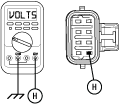
Compare reading(s) in table.
If readings are in range, Go to Step W
If readings are out of range, replace Transmission Harness. Go to Step V
| Pins | Range | Reading(s) |
|---|---|---|
| H to Ground | Within 1.2 V of Battery Voltage |
Key off.
Disconnect 38-Way Transmission Harness Connector.
Verify connector is free from any corrosion; the terminals are not bent, spread or loose; and there is no damage to the connector body.
Measure resistance between 38-Way Transmission Harness Connector Pin 30 and 8-Way Gen1 ECA Connector Pin A. Record reading in table.
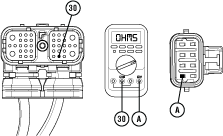
Measure resistance between 38-Way Transmission Harness Connector Pin 30 and ground. Record reading in table.
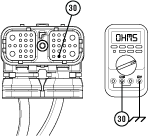
Compare reading(s) in table.
If readings are in range, Go to Step X
If readings are out of range, replace Transmission Harness. Go to Step V
| Pins | Range | Reading(s) |
|---|---|---|
| 30 to A | 0.0–0.6 ohms | |
| 30 to Ground | Open Circuit (OL) |
Key off.
Measure resistance between 38-Way Transmission Harness Connector Pin 29 and 8-Way Gen1 ECA Connector Pin B. Record reading in table.
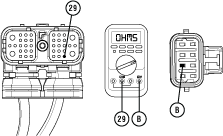
Measure resistance between 38-Way Transmission Harness Connector Pin 29 and ground. Record reading in table.
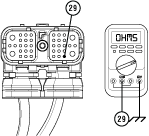
Compare reading(s) in table.
If readings are in range, Go to Step Y
If readings are out of range, replace Transmission Harness. Go to Step V
| Pins | Range | Reading(s) |
|---|---|---|
| 29 to B | 0.0–0.6 ohms | |
| 29 to Ground | Open Circuit (OL) |
Key off.
Reconnect 3-Way ECA Connector.
Reconnect 8-Way ECA Connector.
Reconnect 38-Way Transmission Harness Connector.
Locate and remove the 2-Way HIL Terminating Resistor from the 2-Way Terminating Resistor Connector Body wired into the 8-Way Gen1 ECA Connector (Transmission Harness).
Note: Reference the Component Identification section.
Inspect the 2-Way Terminating Resistor Connector Body for damage and bent, spread, corroded or loose terminals.
Measure resistance at the 2-Way Terminating Resistor Connector Body wired into the 8-Way Gen1 ECA Connector (Transmission Harness) between Pin 1 and Pin 2. Record reading in table.

Note: The resistance of the HIL varies based on the transmission shift device equipped in the vehicle.
Reinstall the 2-Way HIL Terminating Resistor into the 2-Way Terminating Resistor Connector Body.
Compare reading(s) in table.
If readings are out of range, replace Transmission Harness. Go to Step V
If readings are in range, replace Electronic Clutch Actuator (ECA). Go to Step V
| Pins | Range | Reading(s) |
|---|---|---|
| 1 to 2 (with Eaton PBSC) | 50–70 ohms | |
| 1 to 2 (without Eaton PBSC) | 110–130 ohms |
Key off.
Reconnect all connectors and verify that all components are properly installed.
Key on with engine off.
Clear fault codes using ServiceRanger.
Drive vehicle and attempt to reset the code or duplicate the previous complaint.
Check for fault codes using ServiceRanger.
If no fault codes set Active and vehicle operates properly, test complete.
If Fault Code 16 sets Active, refer to Contact Information and contact Eaton for further diagnostics.
If a fault code other than 16 sets Active, troubleshoot per Fault Code Isolation Procedure Index.